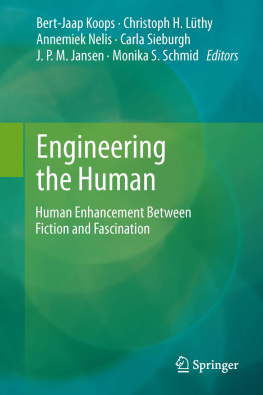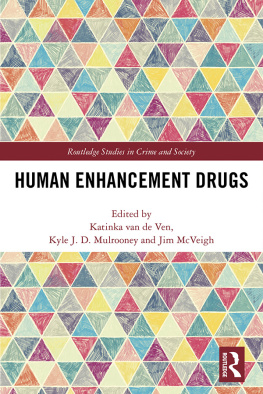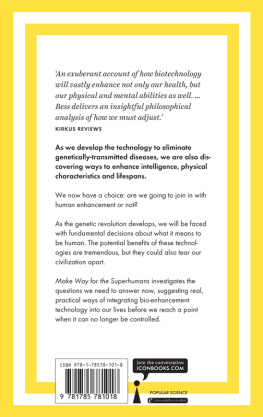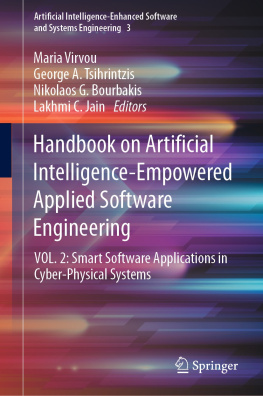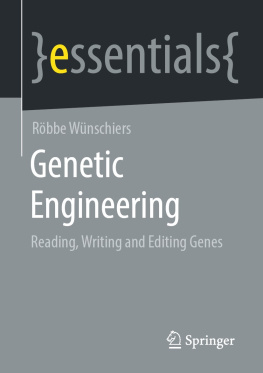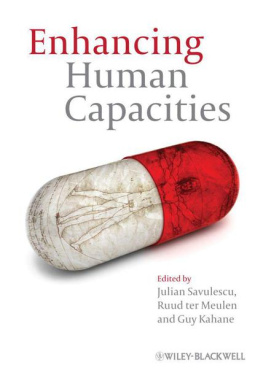Transhumanist Scenarios
The Transhumanist Declaration of begins with the following statement:
1. Humanity stands to be profoundly affected by science and technology in the future. We envision the possibility of broadening human potential by overcoming aging, cognitive shortcomings, involuntary suffering, and our confinement to planet Earth (The Transhumanist Declaration ).
One is tempted to reformulate these sentences in the present tense: today, humanity is profoundly affected by science and technology. Does our rising life expectancy not testify to impressive successes in combating the process of ageing? Are our cognitive shortcomings not already made up for by electronic gadgets and psychopharmaceuticals? Is much involuntary suffering not being alleviated or entirely done away by todays medical treatment?
The Transhumanist Declaration () is, however, not about recent medical, technological and scientific advances, but emphasises a vision of the near futurea prediction, moreover, which it welcomes and embraces. It is based on the assumption that the various recent technological accomplishments will soon converge, and that this convergence should bring about a new type of human being, the transhuman mentioned in the manifestos title.
A number of scenarios have been developed, some by real or would-be scientists, others by science fiction authors or filmmakers, in which the world resembles that of Star Wars , where human beings live together with intelligent robots and modified man-machines. These will soon become symbiotic, leading to a synergy between men and machines that few anticipated, according to Benford and Malartre (), in turn, predicts that
the most important and radical application particularly of circa-2030 nanobots will be to expand our minds through the merger of biological and nonbiological or machine intelligence. In the next 25 years, we will learn how to augment our 1000 trillion very slow interneuronal connections with highspeed virtual connections via nanorobotics. This will allow us to greatly boost our pattern-recognition abilities, memories, and overall thinking capacity, as well as to directly interface with powerful forms of computer intelligence. The technology will also provide wireless communication from one brain to another. In other words, the age of telepathic communication is almost upon us. (43)
Or take the philosopher Bostrom () hopes will be healthier, wittier, happier people, who moreover may be able to reach new levels culturally (498).
The majority of contemporary scientists find most of these predictions highly unrealistic. They either consider it unlikely that the envisaged merger of nanotechnology, engineering and biotechnology can be carried out as predicted; or they reject the proposed time frame between 2020 and 2050 as implausibly soon; or, when they do give some credit to these scenarios, they suggest that legislation or ethical standards will prevent them from being implemented.
Man-made Man?
Whether plausible or not, such scenarios inevitably provoke discussions, cause anxieties, engender fantasies and nurture expectations. Discussion may take on a variety of forms, ranging from science fiction novels and movies to proceedings of ethics conferences, from advisory policy reports to public debates. Moreover, each country or, rather, each linguistic community conducts these discussions differently. This has to do with the terminology that is used to refer to the bundle of medical, technological and scientific procedures that are allegedly transforming humankind. In English, the term human enhancement dominates the debate, implying the improvement of the already existing functions and capacities, while the alternative terms artificial man or transhuman imply a disruptive discontinuity between current, naturally engendered human forms and future, artificial ones. The German expression die Perfektionierung des Menschen (perfectioning of man), by contrast, possesses, like enhancement, a positive connotation of improvement, but not of discontinuity. The alliterative Dutch expression de maakbare mens (makeable man), in turn, provides a more value-neutral term that can include any of the current techniques applied to changing human naturenot all of which need to aim at enhancement.
The present collection of essays was first written for a Dutch-speaking audience, and it carried in its original title the local catch-all termmakeable manwhich indeed stands for all kinds of procedures enhancing, improving or indeed engineering humans. The 12 sections of the 2003 Technology Festival held at Amsterdam, which dealt with the issue of the makeable man, convey an idea of the diverse connotations of this term:
Cloning
Prenatal selection of babies
Gene therapy
Techniques of conditioning behaviour
Neurosurgery
Replacement medicine
Cosmetic surgery
Anti-ageing
Top-class sport (enhanced performance)
Cybernetics (applying artificial intelligence to human beings)
Nanotechnology and its use inside the human body
Nutrition
It turns out that this untranslatable catch-all term, makeable man, offers a range of advantages over expressions such as human enhancement. Precisely because of the all-inclusiveness of the term, Dutch and Flemish society has benefited from a comprehensive discussion. The debate has taken future scenarios of converging technological, medical and scientific advances seriously, has attempted to gauge their likelihood and to fathom possible advantages and disadvantages, and has contemplated the ethical and political limits that ought possibly to be formulated. Here are some examples. The just-named 2003 Technology Festival in Amsterdam was entitled Homo Sapiens 2.0: Festival about the Makeable Man. In 2004, the Flemish Institute for Science and Technology Assessment organised an essay contest with Makeable Man as its theme. In translation, the description of the essay question read as follows: Artificial muscles for the disabled. A chip implanted in your head. Technology makes man. Dream or nightmare? Three years later, in 2007, the Rathenau Institute, a technology assessment body advising Dutch parliament, asked scientists and philosophers whether there should be limits to the engineering of makeable humans. Yet another year later, an organisation called Makeable Man ( De Maakbare Mens ), which describes itself as a critical movement for bio-ethics, invited entries for a photo contest about Sports and the makeability of humans ( www.demaakbaremens.org ). Finally, Maastricht University has over the past few years offered its students a course entitled Makeable Man in its Bachelor degree programme Arts and Culture. This list could be continued ad nauseam; for example, by adding numerous magazine and newspaper articles that have addressed the issue.

